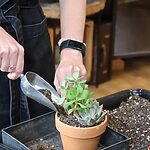☀️ Light
☀️☀️▫️ (Medium)
The Calathea White Fusion Prayer Plant thrives in medium light conditions. It prefers bright, indirect sunlight, so placing it near a window with a sheer curtain is ideal. Avoid direct sunlight, which can fade its vibrant leaves.
💧 Water
💧💧▫️ (Medium)
Keep the soil of your Calathea White Fusion consistently moist but not waterlogged. Water it when the top inch of soil feels dry. Use lukewarm, filtered water to avoid leaf tip browning.
🌡️ Temperature
🌡️🌡️▫️ (Average)
This tropical plant enjoys average room temperatures between 18°C to 24°C. Avoid placing it in draughty areas or near heating and air conditioning vents.
💦 Humidity
💦💦💦 (High)
Calathea White Fusion loves high humidity. Regular misting, a pebble tray, or a humidifier can help meet its humidity requirements, making it perfect for bathrooms or kitchens.
🌱 Repotting
Repot your Calathea every two years or when it outgrows its pot. Use a well-draining, peat-based potting mix. Ensure the new pot has adequate drainage holes.
🐾 Pet Friendliness
This plant is non-toxic and safe for cats and dogs, making it a worry-free choice for pet owners.
🏡 Recommended Locations at Home
Ideal spots for your Calathea White Fusion include bathrooms, kitchens, or any area with filtered light and high humidity. Keep it away from direct sunlight to prevent leaf damage.
🍃 Air Purifying
Calathea White Fusion is known for its air-purifying properties, helping to improve indoor air quality by filtering out pollutants.
✨ Other Plant Features
Beyond its air-purifying abilities, the unique marbled foliage of the Calathea White Fusion brings a touch of exotic beauty to your home décor, with each leaf featuring a distinct pattern of white and green.
If you have more questions, feel free to ask Mossbot or contact us via our website. Don’t forget, we also offer a free plant hospital service if your plants need extra care!
 Calathea White Fusion Prayer Plant
Calathea White Fusion Prayer Plant




















Reviews
There are no reviews yet